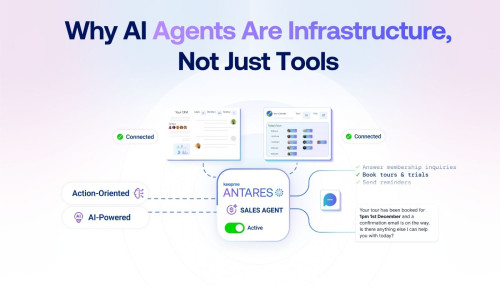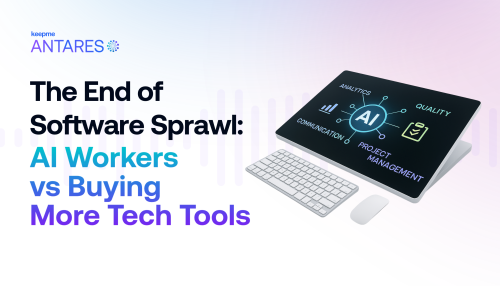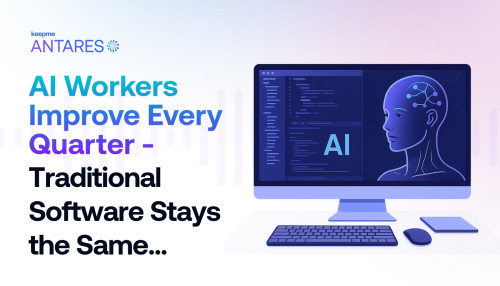The Prediction Problem
There's an old joke among economists: we've successfully predicted nine out of the last two recessions. The same might be said for bubble predictions. Since ChatGPT launched in November 2022, we've witnessed an endless parade of warnings about AI becoming the next dot-com disaster.
Approximately 54% of fund managers now believe AI stocks are in bubble territory. Goldman Sachs CEO David Solomon anticipates significant capital losses. Jeff Bezos described it as "kind of an industrial bubble." Even OpenAI's Sam Altman cautioned that "people will overinvest and lose money."
So are we in a bubble? The short answer is no, but that answer needs significant unpacking.
This isn't contrarian hot-taking. There are legitimate concerns regarding frothy valuations, circular financing, and concentration risk. But calling something a bubble requires precision. More importantly, it requires separating two fundamentally different questions that keep getting conflated.
Two Very Different Questions
When people say "AI bubble," they're typically addressing one of two things:
The Stock Market Question: Are AI-related stocks overvalued to the point where significant correction is inevitable?
The Technology Question: Is artificial intelligence itself overhyped? Will it fail to deliver meaningful economic value?
These questions are related but not identical. You can have a stock market correction whilst the underlying technology continues transforming the economy. In fact, this is precisely what happened with the dot-com crash. The internet didn't stop being revolutionary just because Pets.com went bankrupt.
The key distinction: even if AI stocks correct significantly, the technology will continue advancing, companies will keep deploying it, and its economic impact will accelerate. Stock prices are forward-looking and sentiment-driven. Technology adoption is driven by utility and return on investment.
Some analysts have suggested that an AI stock correction could impact up to 8% of US household wealth. But this framing is misleading. A correction in stock valuations doesn't make the underlying companies disappear. They'll still exist. They'll still have customers. They'll still be building AI systems that drive genuine productivity gains. What changes is the price investors pay for those future earnings, not the fundamental business reality.
What the Bubble Warnings Get Right
Let's start with legitimate concerns:
Extreme Market Concentration: Just two companies, Nvidia and Microsoft, alongside a handful of other tech giants, account for a disproportionate share of AI-related market gains. AI-related stocks have accounted for 75% of S&P 500 returns since ChatGPT launched. When this much market performance hinges on a handful of names, any stumble has outsized consequences.
Venture Capital Concentration: In early 2025, AI startups captured 58% of all global venture capital. No single sector has ever dominated VC to this extent, not even during the dot-com peak. That level of concentration is a warning sign.
Circular Financing: Nvidia investing $100 billion in OpenAI whilst OpenAI pledges to buy Nvidia chips. Microsoft holding equity in OpenAI whilst also being a major customer of CoreWeave, where Nvidia also has equity. OpenAI committing $300 billion to Oracle over five years. When the lines between revenue and equity blur to the tune of hundreds of billions of dollars, we should pay attention.
Extraordinary Valuations: Some AI startups are valued at $400 million to $1.2 billion per employee. OpenAI's valuation has swung between $100-500 billion despite revenues in the hundreds of millions. These are remarkable multiples by any standard, and they warrant scrutiny.
The Critical Distinctions: Why This Time Actually IS Different
The bubble narrative falls apart under scrutiny. There are fundamental differences between 2000 and 2025.
Profitability: Then vs Now
During the dot-com bubble, only 14% of tech companies were profitable. The business model was "grow users, figure out monetisation later." Most never did.
In March 2000, the Nasdaq traded at a price-to-earnings ratio of 60x. Today it trades at 26x, less than half. More importantly, the major AI companies are spectacularly profitable. Nvidia has a 53% net margin. Microsoft, Google, and Apple are generating substantial profits with established business models.
As Federal Reserve Chair Jerome Powell noted: "They actually have earnings. These companies actually have business models and profits. So it's really a different thing" from the dot-com bubble.
Adoption: Speculation vs Reality
In 2000, approximately 50% of US households had internet access. Most were on dial-up. The user experience was crude. E-commerce was tiny. The business cases were largely speculative.
By 2024, 78% of companies globally report using AI. ChatGPT reached 100 million users faster than any app in history, then grew to 600 million in two years. This isn't speculation about future adoption; it's documented deployment at scale.
Major enterprises aren't running pilot projects; they're integrating AI into core operations. Goldman Sachs uses it for code generation. Walmart for supply chain optimisation. Healthcare systems for diagnostics. Law firms for document review. Thousands of fitness clubs now use AI sales agents. This is genuine utility delivering real ROI.
Revenue Growth: Projections vs Actuals
Dot-com companies projected hockey-stick growth that never materialised. AI companies are reporting it now.
Nvidia projected $120 billion revenue for fiscal 2025, roughly double the prior year. Cloud providers report strong AI services uptake. Meta grew profits by leveraging AI for ad targeting. Enterprise software companies see AI driving contract expansions.
This is happening now, not in some speculative future. Customers are paying real money because they're seeing real returns.
Infrastructure Investment Is Rational
Yes, there's massive infrastructure build-out. But Powell framed it correctly: "It's based on longer-run assessments that this is going to drive higher productivity."
Goldman Sachs estimates the productivity unlocked by AI could be worth $8-19 trillion in present value to the US economy. This might seem absurd, but so was fibre optic cable investment in the 1990s, yet we're still using that infrastructure today. Physical infrastructure investments create lasting value even when some companies fail.
It's Not Just Software
The AI boom is showing up in the real economy in ways dot-com never did. As Powell noted: "It's the investment we're getting in equipment and all those things that go into creating data centres. It's clearly one of the big sources of growth in the economy."
Cranes, concrete, capital goods. Industrial power demand at record levels. Physical transformation at industrial scale.
The Historical Lens: "Bubbles" That Were Just Early
Here's a critical insight that bubble predictors consistently miss: many past "bubbles" weren't wrong about the technology, they were just early about the timeline.
Consider Pets.com, the poster child of dot-com excess. It spent millions on marketing, delivered pet food at a loss, and spectacularly failed. The lesson was supposed to be: "The internet doesn't change retail!"
Except now Chewy has a $13 billion market cap doing precisely what Pets.com tried to do. Amazon dominates retail. The business model was right. The infrastructure wasn't ready. Broadband penetration was too low. Logistics networks weren't optimised. User behaviour hadn't shifted.
The same pattern repeats across dot-com failures:
Webvan (grocery delivery): Now we have Instacart and Amazon Fresh
Kozmo (on-demand delivery): Now we have DoorDash and Uber Eats
eToys (online toy sales): Amazon dominates toy sales
Were these bubbles? Or were they entrepreneurs who saw the future correctly but couldn't bridge the gap between vision and infrastructure readiness?
Marc Andreessen, co-founder of Netscape, and now co-founder and general partner at Andreessen Horowitz sums it up perfectly: "The narrative was correct, but the market bet that narrative would play out a lot faster than it ultimately did."
Cloud computing was called a bubble in its early days. Why would enterprises trust their data to Amazon? Mobile was going to be a disaster. Who needs apps when you have mobile websites?
The technology waves were real. The hype cycles about timing were off. But patient capital that weathered the corrections was rewarded handsomely.
The Fundamental Difference: We're Already In Production
This is where AI diverges most sharply from previous technology bubbles. We're not speculating about a future where AI transforms work. It's already happening.
AI represents the fourth major technology wave, after PC, internet, and mobile/cloud. Crucially, waves build on each other rather than replacing what came before. The PC enabled the internet. The internet enabled mobile. Mobile enabled cloud. Cloud enabled AI.
Each wave has required progressively more investment, taken longer to reach maturity, and delivered greater economic impact. But the dot-com bubble was unique; it was the only wave that ended abruptly.
Why? Two factors that don't exist today:
Y2K: The year 2000 deadline created forced upgrades and pulled forward IT spending. It was a one-time, non-negotiable event that artificially inflated demand. Nothing remotely similar exists for AI.
Fraud: WorldCom's $11 billion accounting fraud artificially inflated competitive spending on fibre infrastructure. Modern audit standards make such fraud far less likely today.
AI has neither of these artificial demand drivers. What it has instead is genuine, measurable utility across virtually every economic sector.
What About the Risks?
I'm not arguing everything is perfect. There are genuine risks:
Stock market corrections are entirely possible. Valuations are stretched. If Nvidia disappoints on earnings, you could see a sharp tech selloff. That's not a bubble bursting; that's normal market behaviour.
Some AI startups will fail. Many companies raising at absurd valuations with minimal revenue won't make it. That's not a systemic crisis; that's venture capital working as designed.
The pace of capability improvement could slow. If we hit fundamental limitations in model scaling, expectations would need to reset. But even if we froze AI capabilities today, there's a decade of deployment work to extract value from existing technology.
Circular financing could unwind badly. If OpenAI or another heavily interconnected player faces crisis, there could be contagion effects. This is the most legitimate systemic risk.
None of these risks constitute a "bubble" in the sense of a false promise built on nothing. They're execution risks in a genuine technology transformation.
The Path Forward: Not Linear, But Real
The path forward won't be linear. There will be corrections, disappointments, bankruptcies, and "I told you so" moments from the bears.
But the fundamental trajectory is clear. AI will continue improving. Companies will keep deploying it because it delivers real ROI. The productivity gains will compound. The economic impact will expand.
Stock prices will be volatile because that's what stock prices do. But volatility isn't the same as a bubble popping. Amazon's stock price has been cut in half at least three times since going public in 1997. Its business kept growing through all of it.
One useful distinction: equity-financed investment (where investors risk their own capital) can actually benefit society by funding innovation, even if many investors lose money. It's debt-financed bubbles, where losses cascade through the banking system, that create true economic crises.
AI investment is overwhelmingly equity-financed. If valuations correct, investors take losses, but the infrastructure remains, the technology continues advancing, and the companies that survive emerge stronger. That's not a catastrophic bubble; that's creative destruction working as intended.
Why This Matters: Living Through a Historical Inflection
We're living through something genuinely remarkable. The transformation happening right now will be studied for decades. Future students will read about the AI revolution the way we study the Industrial Revolution.
Yes, there's hype. Yes, there's froth. Yes, some investors will lose money. But the underlying reality is that we're fundamentally expanding what's computationally possible in ways that will touch every part of the economy.
Calling this a bubble misses the forest for the trees. It's like standing in 1995, watching Netscape's IPO, and declaring "bubble!" whilst missing that you're witnessing the birth of the internet age. Or standing in 2007, watching the first iPhone launch, and saying "bubble!" whilst missing that mobile computing would reshape society.
The economists might predict nine out of the last two bubbles. But sometimes, just sometimes, the thing everyone's excited about actually IS that important.
This is one of those times.
The Bottom Line
We're not in an AI bubble. We're in the early stages of a fundamental technology shift that will take decades to fully play out.
Stock valuations might correct. Probably will at some point. Some companies will fail spectacularly. There will be setbacks and disappointments.
But the core technology is real. The adoption is measurable. The business models are profitable. The economic transformation is already underway.
That's not a bubble. That's just the messy, volatile, exhilarating reality of living through a technological revolution.
The real question isn't whether we're in a bubble. It's whether you're paying attention to the incredible times we're living through.
What This Means for Fitness Operators
If you're waiting for the AI bubble to burst before investing, you're conflating two different things. Stock prices might correct. That changes nothing about AI's utility in your business.
Fitness operators deploying AI sales agents today aren't betting on Nvidia's share price. They're building operational capabilities that compound monthly. Every conversation trains the system. Every conversion improves future performance. This infrastructure appreciates, not depreciates.
Whilst markets debate valuations, your competitors are building this advantage. The question isn't whether AI is real. 1,800 clubs globally already know it is. The question is whether you're building capability now, or explaining later why you waited for clarity that never comes.
Technology revolutions don't announce themselves with certainty. They reward those who recognize them whilst others are still debating.
---3.png)




